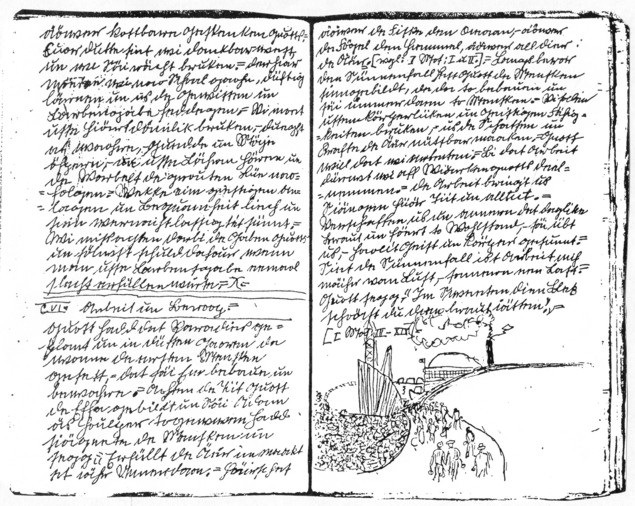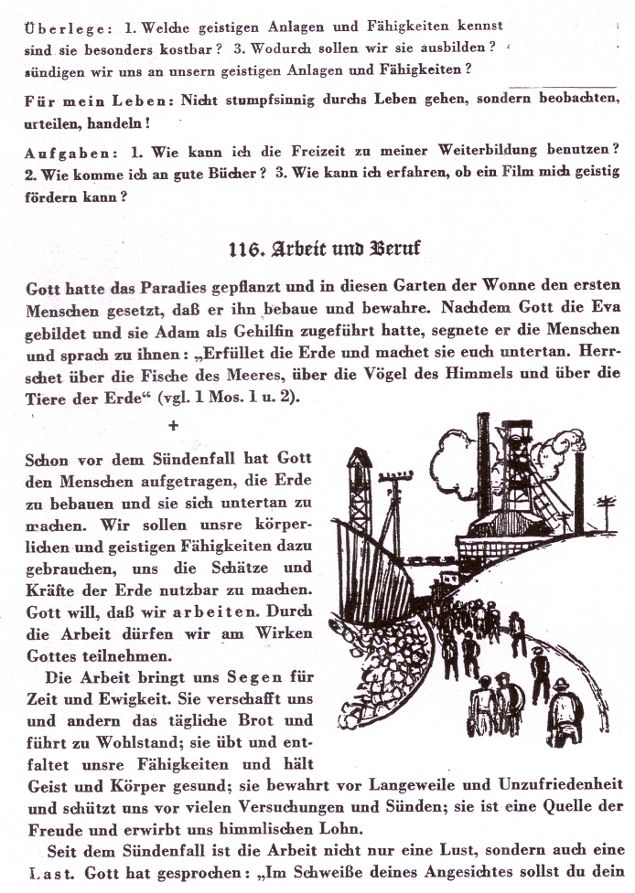| Antonius Holtmann: | No Masterpiece or : How
"Liwwät Böke" Was Adorned With Borrowed Plumes (2012) |
"Plattdütsken Katholisken Katekismus van Didmar Böke, jäöhr 1545, wier
Gärd Böke 1667, bi Bieste / Nellinghof” (“Low German Catholic Catechism 1545
and 1667”)
Luke Knapke
did not include this text (276 pages with more than 160 illustrations) in his
book. 'Liwwät' points out that she copied it between 1819 and 1827 from
originals of 1547 and 1667, i. e. when she was aged 12-20. On the last page
"Liwwät" notes: "de beller hewes ik maolt". (I drew the
illustrations.).
This
statement is false. It is impossible that the illustrations were drawn in the
1820s, neither the factory building, nor the men at a conference table or the
group calling to mind Barlach (a German sculptor and illustrator) and the
Catholic ecclesiastical art in Germany of the 1950s.
There are
other indications which make it unlikely that the text was originally produced
in the 16th and 17th century:
Under the heading "world mission" it is stated
among other things: "In de Mission Lant in Afrika-Mission arbäiten
Pastoren, Bröer, Schwester, Katekesten, Lährer-Lährin, Ärzte un annere Hölper.
– de Möisten Missionaren kommt ut Christlüke Lant, - anneren stammt ut dat
Missionlant süwer. ... dien Gelt dient de Bau von Kjärken, Schol, un
Krankenhüüse." This
phrasing clearly originates from this century, and missionary work in Africa was not performed prior to the discoveries and the
colonialism of the 19th century.
The “Low
German Catholic Catechism” (written 1547 / 1667 and copied 1819-1827 by
‘Liwwät’) has informations about the “Bonifatiusverein” (instituted in 1849)
and about the “Schutzengelverein” (instituted in 1921). The American branch of
the St. Boniface Society has been instituted in 1923 (www.bonifatiuswerk.de).
This catechism must have been written later than 1921.
Luke Knapke
(194): “”We have been told that catechisms were copied for use in the home
before printed copies were readily available. This copy contains more than 160
illustrations drawn by Liwwät Böke.”
Luke
Knapke: “Low German Catechism. Again a book of old Paper . . . In 1979 a German
museum director offered Vincent Boeke much money for this. Said they heard of
it but never seen one” (Luke Knapke: Protocol of his conversation with me in
Minster, May 28, 1988).
If
Vincent Böke would have presented his handwritten catechism, the
director would have replied (being a Catholic): “I know the original
book. We had it in our family, and I used it in the religious
instruction”.
This
“catechism” is a plagiarism and a forgery.(12d)

|
| "Liwwät": "Arbeit un Beroop" |
 |
"Liwwät": "Labour and Profession"
Katholischer Katechismus der Bistümer Deutschlands (1956)
Catholic Catechism of the German Dioceses (1956) |
[12d]
The model of this plagiarism , translated from High German into Low
German, is: Katholischer Katechismus der Bistümer Deutschlands. Ausgabe
für das Bistum Münster. Münster: Verlag Aschendorf 1956 (Lizenzausgabe
der im Verlag Herder in Freiburg im Breisgau erschienenen Musterausgabe
des deutschen Einheitskatechismus). The drawings are made by Albert
Burkart, 1898-1982, 1949-1963 Professor in Frankfurt/Main. Nearly every
Catholic family had this bestseller.



